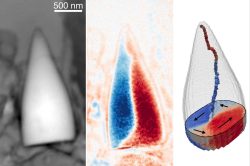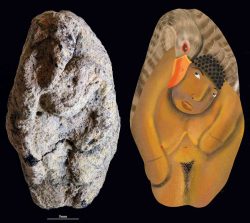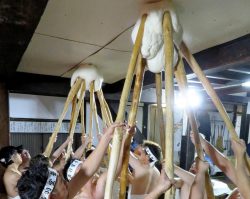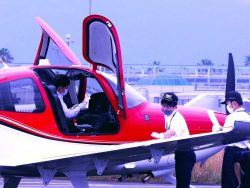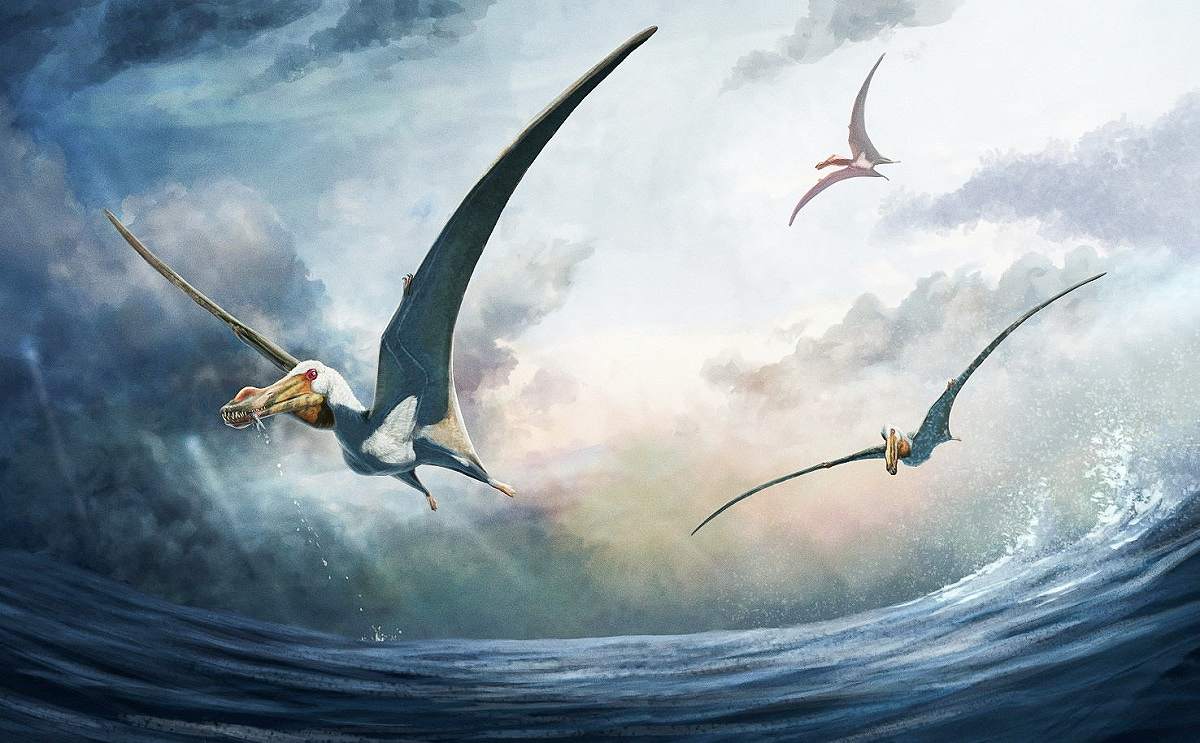
A life reconstruction of the newly identified Cretaceous Period pterosaur Haliskia peterseni, which lived in Australia about 100 million years ago, is seen in this illustration.
11:36 JST, July 12, 2024
Long ago in the skies above the shallow Eromanga Sea, which once covered what is now arid inland Australia, soared a formidable pterosaur — “flying reptile” — boasting a bony crest at the tip of its upper and lower jaws and a mouthful of spike-shaped teeth ideal for snaring fish and other marine prey.
Scientists have announced the discovery in the Australian state of Queensland of fossils of this creature, which lived alongside the dinosaurs and various marine reptiles during the Cretaceous Period. Called Haliskia peterseni, its remains are the most complete of any pterosaur ever unearthed in Australia.
It had a wingspan of 4.6 meters and lived about 100 million years ago, making Haliskia a bit larger and older — by about 5 million years — than the closely related Australian pterosaur Ferrodraco, whose discovery was announced in 2019.
Haliskia means “sea phantom,” and this creature may have been a frightful sight airborne above the waves.
“The Eromanga Sea was a massive inland sea covering large parts of Australia when this pterosaur was alive, but both have vanished. The ghost of both of these is evident from the fossils found in the area,” said Adele Pentland, a doctoral student in paleontology at Curtin University in Australia and lead author of the study published in the journal Scientific Reports.
The fragile skeletons of pterosaurs do not lend themselves well to fossilization. For Haliskia, 22% of the skeleton was unearthed, with complete lower jaws, the tip of the upper jaw, throat bones, 43 teeth, vertebrae, ribs, bones from both wings and part of one leg.
“We inferred the presence of a muscular tongue based on the relative length of the throat bones, compared to the length of the lower jaw,” Pentland said.
“In many other pterosaurs, the throat bones are 30% or 60% the length of the lower jaw, whereas in Haliskia the throat bones are 70% the length of the lower jaw. This meant that whilst hunting fish and squid-like cephalopods, Haliskia might have had an advantage and been able to trap live prey in its jaws,” Pentland added.
Pentland said she was “astounded” that the Haliskia specimen preserved throat bones. “These are as thin as a piece of spaghetti, and one is complete from end to end,” Pentland said.
Haliskia’s remains are more complete than those of Ferrodraco. Both are members of a pterosaur group called anhanguerians known from remains found in China, the United States, Brazil, England, Spain and Morocco. The three other named Australian pterosaurs are known only from partial jaw bones, Pentland said.
After dying, the Haliskia individual’s body ended up buried under sediment at the bottom of the Eromanga Sea, allowing its fossilization. The creature’s name also honors Kevin Petersen, an avocado farmer turned Kronosaurus Korner museum curator who discovered its remains in 2021.
Pterosaurs were the first of three vertebrate groups to achieve powered flight, appearing about 230 million years ago. Birds appeared about 150 million years ago and bats around 50 million years ago. The pterosaurs were wiped out in the same mass extinction event that doomed the dinosaurs, aside from their bird descendants, 66 million years ago following an asteroid strike.
“Pterosaurs occupied various ecological niches, with small pterosaurs feeding on insects, whilst others were piscivores feeding on fish, whereas others were scavengers. The smallest pterosaurs had wingspans of about 25 centimeters, whereas the largest pterosaurs had wingspans rivaling small fighter jets and were the largest animals to have soared through the skies,” Pentland said.
Knowledge of Haliskia adds to the understanding of life in Australia during the Mesozoic Era, when dinosaurs ruled the land.
“This discovery is significant as it was presumed for many years that Australia had very few fossils from the age of dinosaurs,” Pentland said.
"Science & Nature" POPULAR ARTICLE
-

Mass Oyster Die-Offs Confirmed in Japan’s Seto Inland Sea; High Water Temperature Cited as Primary Cause
-

Researchers in U.S., Japan Offer Insight into Ghostly Neutrinos
-

Big Leap in Quest to Get to Bottom of Climate Ice Mystery
-

Security Camera Footage Vulnerable to Outside Access; Investigation Finds 3,000 Pieces Exposed Online
-

Japan Plans to Develop System of AI Evaluating Credibility of Other AI Models
JN ACCESS RANKING
-

Govt Plans to Urge Municipalities to Help Residents Cope with Rising Prices
-

Japan Resumes Scallop Exports to China
-

Japan Prime Minister Takaichi Vows to Have Country Exit Deflation, Closely Monitor Economic Indicators
-

Japan to Charge Foreigners More for Residence Permits, Looking to Align with Western Countries
-

Japan GDP Down Annualized 1.8% in July-Sept.


